Separation Anxiety in Dogs: A Common Challenge for Pet Owners
Separation anxiety can be a significant concern for many dog owners. When left alone, our furry friends may experience stress, fear, and anxiety, leading to destructive behavior and excessive vocalization. Fortunately, there are several practical strategies you can implement to prevent separation anxiety and ensure your pup feels safe and content when you’re away. From creating a comforting environment to gradual desensitization, let’s explore eight effective tips to help your dog overcome separation anxiety and thrive.
1. Establish a Consistent Routine
Dogs thrive on routine, so establishing a consistent daily schedule can significantly alleviate separation anxiety. Stick to regular feeding times, exercise routines, and designated periods for rest and play. By providing predictability and structure, you create a sense of security for your pup, reducing their anxiety levels when you’re not around.
2. Gradually Introduce Alone Time
If your dog struggles with being alone, start by gradually increasing the time spent apart. Begin with short periods where you leave the room or house and gradually extend the duration over several weeks. This gradual desensitization helps your furry companion build confidence and learn that being alone doesn’t mean abandonment.
3. Provide a Safe and Cozy Space
Creating a comfortable space for your dog can help alleviate separation anxiety. Designate an area in your home where your pup can retreat to and feel safe. Consider using a crate or a cozy corner with their bed, favorite toys, and familiar scents. This special space will provide a sense of security and become their go-to spot when you’re not around.
4. Use Interactive Toys and Puzzles
Interactive toys and puzzles can work wonders in keeping your dog mentally stimulated and distracted from their anxiety when left alone. Consider treat-dispensing toys or puzzle games that challenge their problem-solving skills. These engaging activities not only keep their minds occupied but also help create positive associations with alone time.
5. Practice Short Departures
Before leaving your dog for an extended period, practice short departures. Briefly step outside the door and return after a few minutes. Gradually increase the time you’re away, always ensuring a positive reunion when you come back. These practice sessions teach your pup that departures are temporary and that you’ll always return.
6. Use Calming Aids
In certain cases, natural calming aids can help ease separation anxiety. Options like pheromone diffusers, anxiety wraps, or herbal supplements can have a calming effect on your dog. Consult with your veterinarian to explore suitable calming aids that may assist in reducing your pup’s anxiety levels.
7. Seek Professional Help if Needed
If your dog’s separation anxiety persists despite your best efforts, consider seeking professional help. Veterinarians and animal behaviorists have specialized knowledge and experience in dealing with anxiety-related issues in dogs. They can assess your dog’s specific needs and provide tailored strategies to address their separation anxiety effectively.
A Happy and Secure Dog: Your Efforts Make a Difference
Preventing separation anxiety in dogs requires patience, consistency, and understanding. By establishing a consistent routine, gradually introducing alone time, and providing a safe and cozy space, you can help your furry friend feel more secure and comfortable when you’re away. Incorporating interactive toys, practicing short departures, and considering calming aids when necessary further contribute to their well-being.
Remember, every dog is unique, and overcoming separation anxiety may take time. Stay committed to the process, and don’t hesitate to seek professional guidance if needed. With your love and support, you can ensure your dog experiences a happier, stress-free life, both when you’re together and when you’re apart.
Discover more: Socializing a Rescue Dog: 7 Essential Tips for Success










